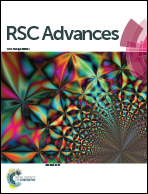Heterogeneous cation induced clusters formed at surfaces of micro-droplets†
Abstract
The surface of a micro-droplet can be treated as a simplified model to study reactions on a cell membrane. A novel group of heterogeneous cations induced clusters (HeteroCICs) that formed at the surface of micro-droplets was discovered by mass spectrometry (MS). This novel category of clusters are produced through two types of cations co-induced self assemblies of thymine molecules. Applying this phenomenon, an on-line derivatization and quantitation method of “ambient MS” style has been established, which can be used to real time monitor fish freshness changes during shelf-life.


 Please wait while we load your content...
Please wait while we load your content...